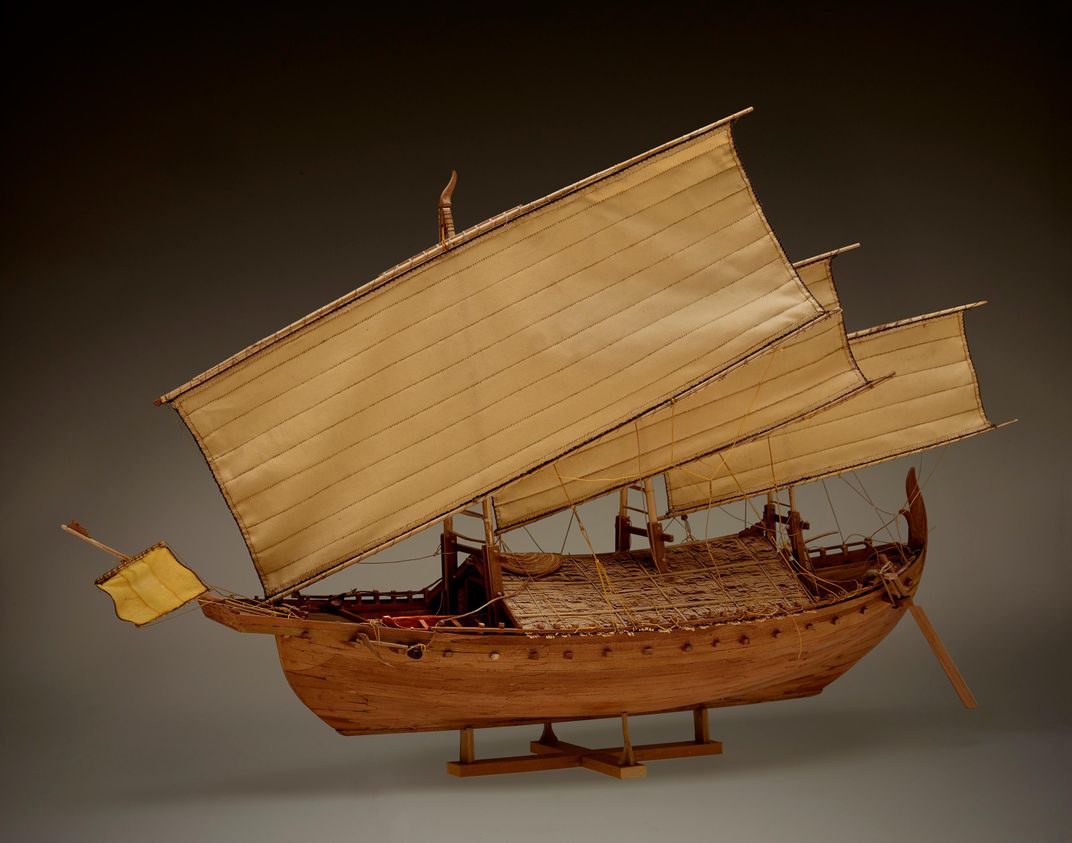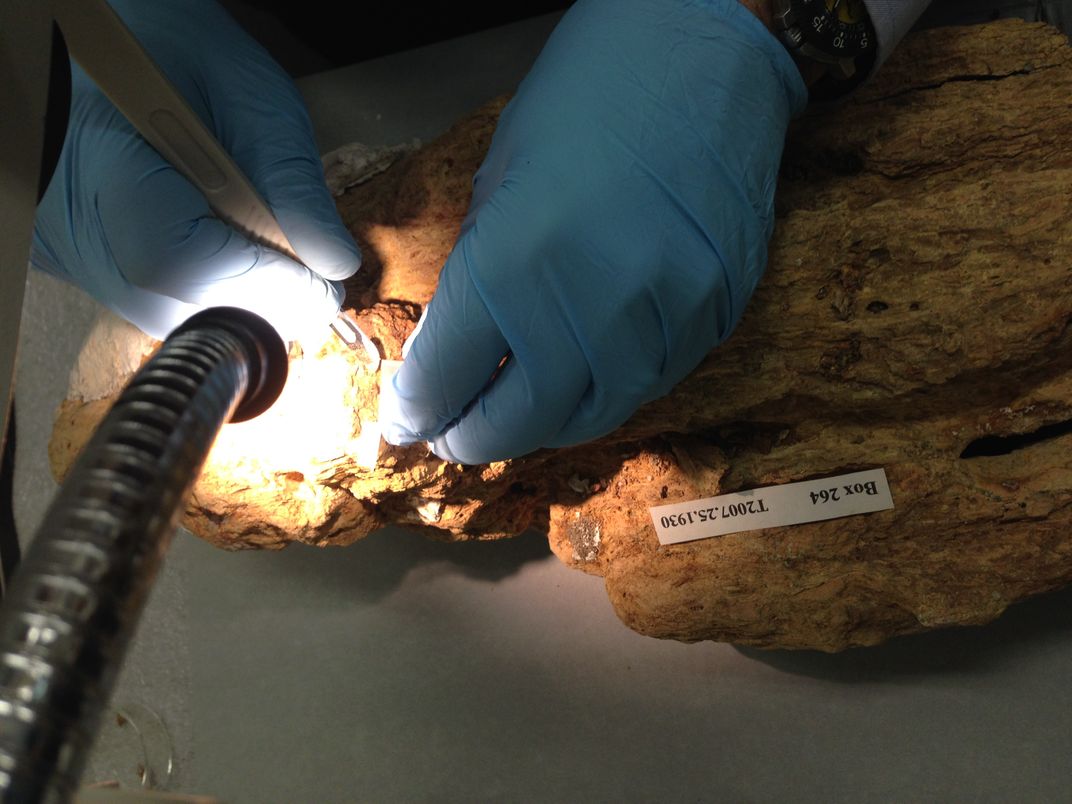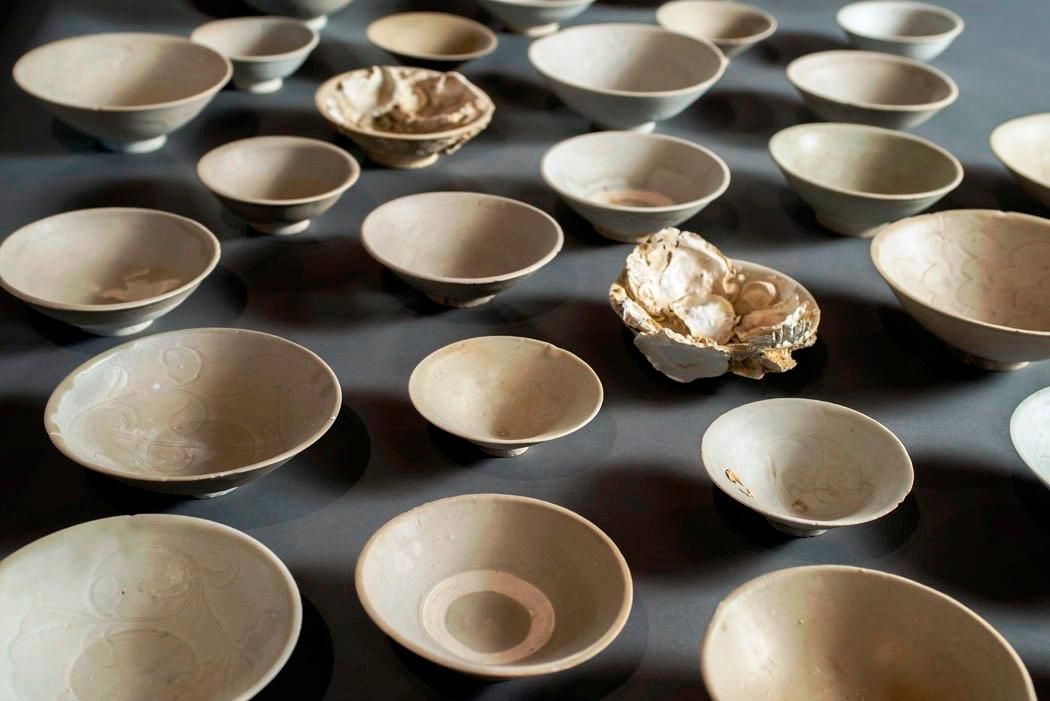An 800-Year-Old Shipwreck Helps Archaeologists Piece Together Asia’s Maritime Trade
A new date for the Java Sea shipwreck could shed light on the politics of Chinese trade routes
/https://tf-cmsv2-smithsonianmag-media.s3.amazonaws.com/filer/d4/3c/d43cf19e-f38c-405b-9c67-a7612cbf8cbd/fig4jswjianningfubox.jpg)
Among the more than 7,500 fragments from the Java Sea shipwreck that reside in Chicago's Field Museum are corroded lumps of iron, exported from China for use as weapons or agricultural tools in Southeast Asia; button-like weights used on merchants’ scales; barnacle encrusted chunks of aromatic resin and crumbling ivory; and thousands upon thousands of ceramic wares. Each ancient object has its own history and context, but it was a tiny inscription on one that helped researchers unlock the mystery behind this wreck—or so they thought.
Etched on only two ceramic containers, the words “Jianning Fu” gave the lidded box a specific provenance. When anthropologist Lisa Niziolek first saw the writing in 2012, she realized that the city name only existed in that form for a brief window of time: “Fu” designated Jianning as a Southern Song dynasty superior prefecture beginning in 1162. By 1278, the city had changed to Jianning Lu, a new designation bestowed by the invading Mongol leader, Kublai Khan. That seemed to fit perfectly with the shipwreck’s initial date of mid-to-late 13th century.
This, Niziolek thought, was the smoking gun. “At first I was all excited that we were looking at this short time period,” she recalls. “We were thinking that it was just within a couple years of that [political] transition.” Narrowing down the shipwreck’s age to such a short range of dates might’ve indicated that this boat sailed during the uneasy transition years between the Song and Yuan dynasties.
But once she began conferring with colleagues in China and Japan about the types of ceramic she was seeing in the collection, she started having doubts. Tantalizing inscription aside, the other experts thought the ceramics more closely matched the style of earlier objects. Archaeologists who first assessed the wreck in the 1990s sent a single sample of resin for radiocarbon analysis, which provided the date range of 1215 to 1405. “It can be said with some certainty that the ceramics cargo does not predate the thirteenth century,” those researchers concluded.
Science is about putting forth a hypothesis, comparing it to the available data, and adjusting it accordingly. So Niziolek and her team decided to submit three more samples for radiocarbon analysis, two from the resin and one from the ivory. Thanks to technological advancements, labs now use accelerated mass spectrometry, a technique that requires smaller sample sizes and provides more precise results than the earlier method, called radiometric dating. The new results gave a significantly earlier date range: from 889 AD to 1261 AD, with the majority of the dates falling between the 11th and 12th centuries.
Those new results, along with a closer comparative analysis of the ceramic styles, were published Wednesday in the Journal of Archaeological Science: Reports. Given the new data, it seemed that the inscription on the bottom of the ceramic box didn’t mark the end of the Southern Song Dynasty—it was probably from the new dynasty’s beginning. If that’s true, it gives researchers an important new starting point to investigate objects from the shipwreck, from where those ceramics were made to which government oversaw the expanding Chinese trade network.
.....

That there’s anything to be studied at all from the Java Sea shipwreck is something of a miracle. The wreck was discovered by fishermen, drawn to the site by the birds feeding on swarms of fish that lived in and around the debris, in the 1980s. At some point those fishermen began diving down to the wreckage, submerged beneath 85 feet of water in the heavily trafficked Java Sea, south of Singapore and near Borneo. In 1993 one of them sold the knowledge of the wreck to a commercial salvage company, which began removing thousands of pieces from the site. (At the time, this type of activity was legal under Indonesian law.)
In 1996, a new salvage company, Pacific Sea Resources, resumed retrieval of the objects, this time with the participation of archaeologists and other experts. By this point, those experts estimated that of the 100,000 pieces of ceramics originally on the boat, only 12 percent remained. They conducted a thorough study of the wreck, using hunks of iron to estimate the size of the ship—about 92 feet long and 26 feet wide. Then, Pacific Sea Resources split the salvaged items between the Indonesian government and the Field Museum.
“The objects could just as easily have been dispersed to auction houses and private collectors, or looted and sold on the black market,” said Natali Pearson, a scholar at the University of Sydney Southeast Asia Centre who has studied other shipwrecks of the region, by email. “This places an unfortunate emphasis on objects of financial value rather than allowing us to think about the assemblage in terms of its historical and archaeological value. With this in mind, studies such as this one are even more valuable.”
Having physical remains is particularly important here because the records left behind by Chinese officials of the time can be selective in their focus. “Those were written by people who went into government, so they’re going to look down at merchants, who were doing it for profit,” says Gary Feinman, curator of Mesoamerican, Central American and East Asian Anthropology at the Field Museum and a co-author on the study. “They have a statist perspective, an elite perspective, and they don’t really give full coverage to other aspects of life that may be there.”
…..

Not all researchers agree with the results of the new paper. “The arguments on the basis of the inscription on the base of the ceramic and the results of AMS dating are not very strong,” said John Miksic, a professor of Southeast Asian Studies at the National University of Singapore, by email. Miksic worked on the shipwreck when it was first excavated in the 90s. He thinks the research hasn’t proved that the original dates for the shipwreck need to be revised, adding that “we do not have very many sites like the Java Sea shipwreck to go by, so our degree of confidence in the dating of such sites does not have a great deal of comparative material for its basis.”
That said, Miksic does agree that there’s plenty to learn from continued analysis of the ship’s cargo. He hopes that at some point more wrecks will be discovered and catalogued, and that a database might be created for comparison of such materials, including ceramics and the assortment of personal items that were on the ship.
Niziolek is already beginning to draw insights from the materials we have. Although we don’t know the identity or fate of the merchants and sailors aboard the ship, we do know they transported their goods during a period of upheaval for China, and for Southeast Asia more broadly. The Southern Song dynasty, founded in 1127, came about as a result of the northern chunk of the country being lost to invaders. Around the same time, it became legal for Chinese citizens to go overseas to trade; previously, only foreign merchants could come to Chinese port cities and sell products.
At this point, goods moved across much of the world on a sort of maritime Silk Road (Niziolek notes that although silk itself was likely on the Java Sea shipwreck, it wouldn’t have survived underwater 800 years, and by that point, ceramics made up the bulk of tradeable items). China had trade relations with an estimated 50 countries. As one historian notes, “by the Song period, the scale of maritime trade had become so large that it may be deemed the first period of great oceanic trade in the history of the world.”
The variety of goods and the distance they came from is reflected in the artifacts housed by the Field Museum. Among the ceramics one finds everything from what Niziolek calls “Ikea bowls”—plain, mass-produced vessels—to ornate ewers with intricate molded decorations of a phoenix and flowers. Then there are the unique pieces, which were probably the personal property of people on the ship: a shard of glass whose chemical recipe matches that of glassware from Egypt; a crouched human figurine that may have been the corner of a small table; bronze pieces that might once have topped the staffs of Buddhist monks.
…..

But there’s also the issue of the material being dated. Both the ivory and the resin were submerged in water for 800 years, which degraded their condition. “I would liked to have seen a date from the corky material from the surface to compare with the date from the inner material,” said Joseph Lambert of the resin sent in for radiocarbon dating. A professor of Chemistry at Trinity University, Lambert was involved in an earlier study on the resin, but not in this one.
Whatever their opinions may be on the likely date for the shipwreck, all the researchers agree on one thing: finds such as this are all too rare. The Java Sea has been an important passage in trade routes for centuries. Thousands of shipwrecks litter the seafloor, from more than a thousand years ago to the World War II era and beyond. Unfortunately, too many of those wrecks have been looted, or damaged in practices like blast fishing.
“While it is wonderful that we are in a position to conduct new research, my concerns going forward relate to the fate of shipwrecks that are still in Indonesian waters,” Pearson says. “Indonesia has new legislation to legally protect underwater cultural heritage, but—as the recent destruction of WWII ships in the Java Sea demonstrates—Indonesia’s ability to physically protect wrecks remains limited.”
Which makes this shipwreck all the more rare and valuable for researchers. Thanks to the fact that these objects belong to the Field Museum, researchers can continue analyzing them to learn more about this period of Asian trade. In one 2016 paper, Niziolek and others analyzed the chemistry of the resin to see where the blocks came from. In the future, they hope to extract ancient DNA from the elephant tusks to learn their origins, and analyze the sediments of large storage jars to see if they held foodstuffs like pickled vegetables or fish sauce. Some day, they also plan to compare the chemical makeup of the ceramics to kiln sites in China to see where merchants purchased them.
Even after two decades above water, the shipwreck still has dozens more stories to tell.
/https://tf-cmsv2-smithsonianmag-media.s3.amazonaws.com/accounts/headshot/lorraine.png)
/https://tf-cmsv2-smithsonianmag-media.s3.amazonaws.com/accounts/headshot/lorraine.png)